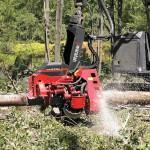 Minimizing costs associated with machine upkeep and replacement goes a long way in helping business owners manage already tight profit margins. For every eight hours harvesting and processing heads run, trained operators should practice regular maintenance to decrease downtime and reduce the risk for equipment failure. Both processing and harvesting heads have the same maintenance requirements, so following these tips can help operators enjoy extended, more productive decked wood processing, treelength felling and cut-to-length applications.
Minimizing costs associated with machine upkeep and replacement goes a long way in helping business owners manage already tight profit margins. For every eight hours harvesting and processing heads run, trained operators should practice regular maintenance to decrease downtime and reduce the risk for equipment failure. Both processing and harvesting heads have the same maintenance requirements, so following these tips can help operators enjoy extended, more productive decked wood processing, treelength felling and cut-to-length applications.
Observe RPM specifications—Do not exceed the maximum RPM speeds set by manufacturers. Doing so causes extra wear on rivets, which in turn increases chain stretching, decreases chain tension and accelerates rivet wear. As rivets hold chains together, their wear compromises connections and can lead to broken or unusable chains.
Rotate the cutting bar—Removing the cutting bar during chain replacement provides the best opportunity to clean out the slash and other materials accumulated in the rail and lubrication holes. To maximize cutting-bar life, rotate the bar during each cleaning to even the amount of wear on both rails. Check for bends and emerging ridges during this process, as these changes can increase binding during cutting and can put added pressure on the guide rail and other parts of the head.
Know your soil—While high-tack, no-sling bar and chain oil can provide the lubrication needed throughout operation, it can also accelerate chain wear in sandy soils, creating abrasive friction between parts. In sandy soils, use regular motor oil, as its thinner consistency helps wash away sand from components.
Check connections—Regularly check equipment for loose bolt and nylon bushing connections, also known as spacer washers. These washers are situated between delimb arms and the head frame and absorb the shock of operation. Not immediately tightening bolts and spacer washers can result in loss of mobility, excessive pin and bushing wear and arm breakage.
Keep grease fittings on site—With an average of 40 to 45 grease points on harvesting and processing heads, it’s imperative to keep supplies of grease fittings on site during every shift. Throughout the course of a day, these fitting points become damaged and require immediate repair to avoid downtime.
Determine leak origin point—When leaks sprout, operators must determine their origin immediately because such leaks can spread and likely never get any better. If not addressed, hydraulic oil can drip from the entire head and eventually seep into electrical components.
Preheat arm and knife inserts before replacement—Preheat delimb arms and knife-replacement inserts before you install them. Equal transference of high-heat temperature throughout the entire arm and knives eliminates equipment breakage during the welding process.
Check measurement accuracy and recalibrate linkages—Check the accuracy of the diameter measurement device, length encoder and length measurement monthly and recalibrate if necessary. As the linkages in these parts loosen, their calibrations become skewed and no longer provide accurate measurements required during applications.
